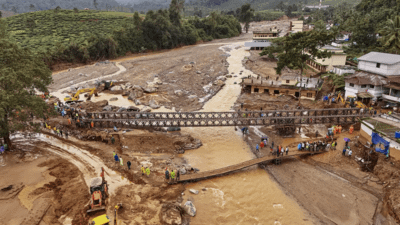The recent declaration of the Wayanad landslides as a disaster of “severe nature” marks governmental response. This decision follows extensive criticism regarding the lack of financial aid for the victims. The landslides occurred on July 30, resulting in over 200 fatalities, numerous injuries, and the displacement of thousands in the region.
What are Severe Natural Disasters?
These are catastrophic events that result in loss of life, property, and environmental damage.
Causes: Can be natural (e.g., earthquakes, cyclones, landslides) or human-induced (e.g., industrial accidents).
Impacts of Severe Natural Disasters
Social: Loss of life, increased vulnerability for marginalized groups (e.g., women, elderly, children) and displacement of communities.
Economic: Destruction of infrastructure (roads, power systems) leading to significant economic losses.
Environmental: Deforestation, habitat loss, soil erosion etc.
Implications of Declaration of Severe Nature
When a disaster is declared of “severe nature,” the state government receives national-level support.
National Disaster Response Fund (NDRF) may provide additional assistance.
Calamity Relief Fund (CRF): A fund shared 3:1 between the Centre and state for immediate relief. If CRF resources are insufficient, the National Calamity Contingency Fund (NCCF), fully funded by the Centre, provides additional support.
Loan Relief: Relief in repayment or concessional loans for affected individuals may also be considered.
Background of the Disaster
The Wayanad landslides were triggered by heavy rainfall. They primarily affected the Chooralmala and Mundakkai areas. This natural disaster has been classified among the most severe in Kerala’s history due to its devastating impact on local communities. The landslides have had a deep effect on the local population. Over 200 lives were lost, and many individuals were injured. Thousands of residents faced displacement, leading to urgent needs for shelter and support services.
Kerala’s Rehabilitation Plan for Wayanad Landslide Victims
The Kerala Cabinet has finalized a comprehensive rehabilitation plan to aid victims of the devastating landslides in Wayanad. The plan aims to restore homes and livelihoods of affected families. The Plan’s Key Aspects Include:
Sustainable Townships:
Two sustainable townships will be constructed:
Elstone Estate (Kalpetta Municipality)
Nedumbala Estate (Meppadi Panchayat)
Townships will be built based on slope analysis to ensure stability in hilly areas.
Facilities include recreational spaces, markets, health centers, schools, playgrounds, anganwadis, veterinary hospitals, and basic amenities like electricity, drinking water, and sanitation.
Land Allocation:
Families will receive land allocations:
Five cents in Elstone Estate
Ten cents in Nedumbalam Estate
The allocation reflects land value differences between the two regions.
Community Support Infrastructure:
Development of commercial spaces, a sports club, and a community center to meet the community’s diverse needs.
Livelihood Restoration:
The micro-plan survey led by Kudumbashree covered 1,084 families across Meppadi Panchayat, identifying livelihood preferences:
192 families interested in agriculture
79 in animal husbandry
1,034 in micro-enterprises
585 in other income-generating activities
Special focus on vulnerable families (e.g., women-headed households, elderly, widows, children).
Drone Survey and Legal Support:
Drone surveys helped identify suitable sites for rehabilitation.
The High Court granted permission for the state government to acquire land for the project.
Timeline and Government Support:
The final list of affected families will be released by January 25, 2025.
A completion timeline for the rehabilitation will be shared in the next 2-3 weeks.
GKToday Notes:
- Wayanad: Wayanad is a district in Kerala. It is known for its scenic beauty and rich biodiversity. The region is also famous for its coffee plantations and wildlife sanctuaries.
- IMCT: The Inter-Ministerial Central Team (IMCT) assesses disaster situations in India. It evaluates the impact and recommends financial assistance. The IMCT plays important role in disaster management and relief efforts.
- SDRF: The State Disaster Response Fund (SDRF) provides immediate financial aid during disasters. It is managed by state governments in India. SDRF funds are crucial for initial relief and rehabilitation efforts.
- NDRF: The National Disaster Response Fund (NDRF) supports disaster management in India. It provides additional financial assistance after initial assessments. NDRF is vital for long-term recovery and rebuilding in affected areas.

Leave a Reply